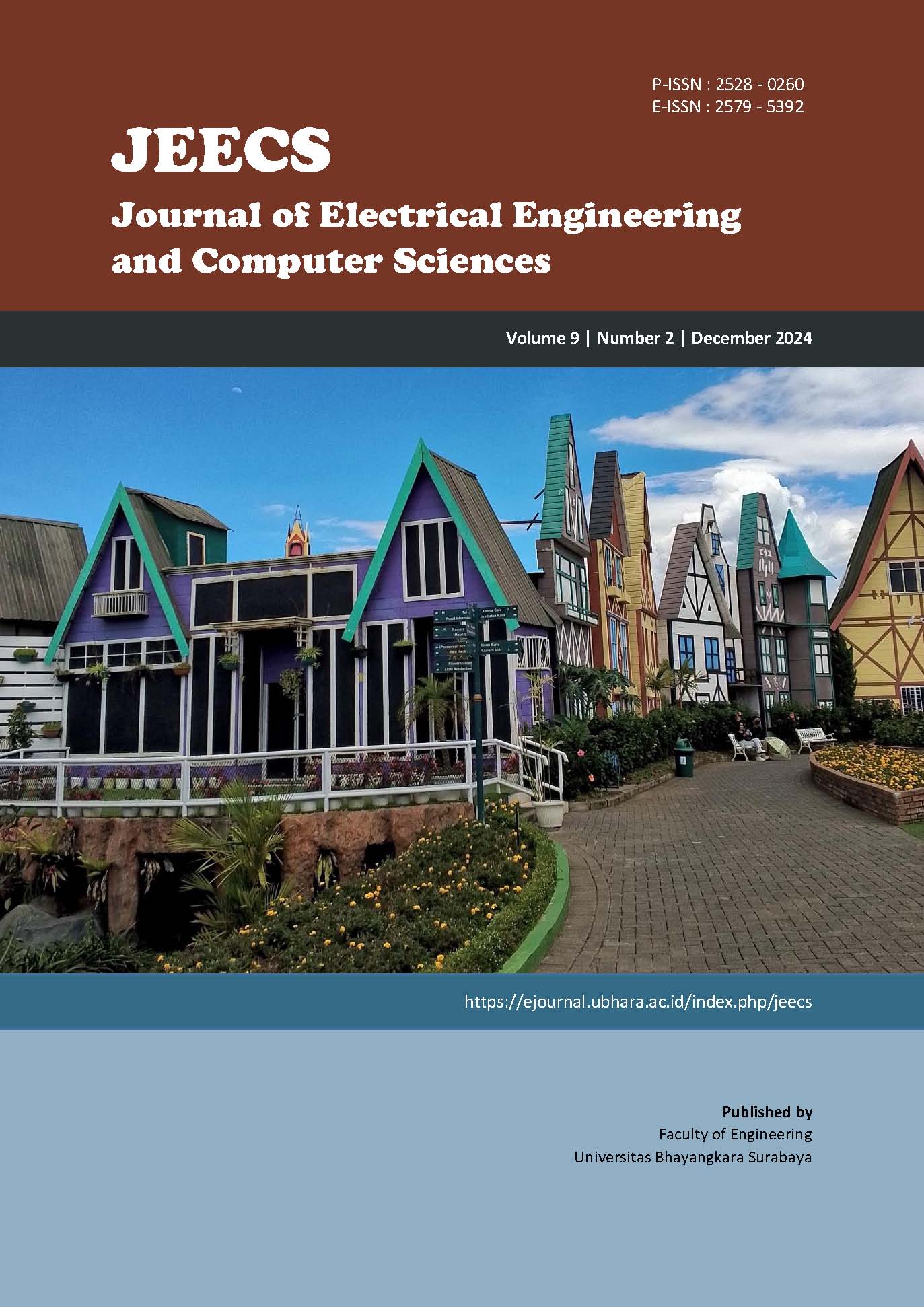Design of an Intelligent Computing-based Information System for Automated Decision Making
Main Article Content
Abstract
The rapid growth of information technology has increased the need for intelligent computing-based information systems across sectors, such as business, education, and government, to facilitate quick and accurate decision-making. Previous research primarily focused on data analysis without a seamless integration for automated decision support. This study aims to bridge this gap by designing an information system that leverages machine learning algorithms for automated decision-making. The system incorporates artificial intelligence and big data processing to provide accurate recommendations based on historical and real-time data patterns. Key processes include identifying user needs, selecting suitable algorithms, developing predictive models, and integrating them into a user-friendly, web-based platform. Results indicate that the intelligent system significantly enhances decision-making speed and accuracy, particularly in scenarios demanding real-time analysis. Tests with decision trees and neural network algorithms demonstrate the system's reliability and adaptability to various data types, supporting consistent, data-driven outcomes. This research concludes by highlighting the system's potential to address complex data challenges, enabling efficient decision-making in dynamic environments.
Article Details

This work is licensed under a Creative Commons Attribution 4.0 International License.
References
P. Agung, A. Z. Iftikhor, D. Damayanti, M. Bakri, and M. Alfarizi, (2020), “Sistem Rumah Cerdas Berbasis Internet of Things Dengan Mikrokontroler Nodemcu Dan Aplikasi Telegram,” Jurnal Teknik dan Sistem Komputer, vol. 1, no. 1, pp. 8–14, doi:10.33365/jtikom.v1i1.47. DOI: https://doi.org/10.33365/jtikom.v1i1.47
R. Aditya, (2021), “Infrastruktur cloud pintar dalam sistem layanan informasi berbasis big data,” INTEGRATED (Journal of Information Technology and Vocational Education), vol. 3, no. 1, pp. 29–38, doi:10.17509/INTEGRATED.V3I1.64423. DOI: https://doi.org/10.17509/integrated.v3i1.64423
Y. Pradifta, T. Avini, and S. Suryati, (2016), “Sistem Infomasi Seleksi Berkas Lamaran Calon Guru Secara Online Pada Sma Lti Indo Global Mandiri Palembang,” Jurnal Ilmiah Informatika Global, vol. 6, no. 1, pp. 3–8, doi:10.36982/jiig.v6i1.46. DOI: https://doi.org/10.36982/jiig.v6i1.46
L. Judijanto, I. W. A. Pratama, I. W. Jata, and E. Y. Utami, (2024), “Analisis Bibliometrik tentang Pengaruh Big Data dan Analitik dalam Pengembangan Produk dan Layanan,” Jurnal Multidisiplin West Science, vol. 3, no. 01, pp. 88–97, doi:10.58812/jmws.v3i01.942. DOI: https://doi.org/10.58812/jmws.v3i01.942
N. S. Lubis and M. I. P. Nasution, (2023), “Perkembangan Teknologi Informasi Dan Dampaknya Pada Masyarakat,” KOHESI: Jurnal Multidisplin Saintek, vol. 1, no. 12, pp. 41–50.
E. A. Kadir, S. L. Roza, and S. P. Rizki, (2020), “Dampak Perkembangan Teknologi Informasi dan Komunikasi Bagi Masyarakat Umum,” Jurnal Pengabdian Masyarakat dan Penerapan Ilmu Pengetahuan, vol. 1, no. 1, pp. 1–6.
N. Yona Sidratul Munti and D. Asril Syaifuddin, (2020), “Analisa Dampak Perkembangan Teknologi Informasi Dan Komunikasi Dalam Bidang Pendidikan,” Jurnal Pendidikan Tambusai, vol. 4, no. 2, pp. 1799–1805.
A. Fauzi, M. Alfhi Syari, and K. Kunci, (2023), “Application of the Learning Vector Algorithm Quantization On Smart Barcodes,” Indonesian Journal of Education And Computer Science, vol. 1, no. 2, pp. 48–55. DOI: https://doi.org/10.60076/indotech.v1i2.41
S. Bharitkar and D. Filev, (2001), “An online learning vector quantization algorithm,” 6th International Symposium on Signal Processing and Its Applications, ISSPA 2001 - Proceedings; 6 Tutorials in Communications, Image Processing and Signal Analysis, vol. 2, pp. 394–397, doi:10.1109/ISSPA.2001.950163. DOI: https://doi.org/10.1109/ISSPA.2001.950163
J. Gea, (2022), “Implementasi Algoritma Learning Vector Quantization Untuk Pengenalan Barcode Barang,” Journal of Informatics, Electrical and Electronics Engineering, vol. 2, no. 1, pp. 1–4, doi:10.47065/jieee.v2i1.385. DOI: https://doi.org/10.47065/jieee.v2i1.385
H. Miyajima, N. Shigei, M. Maeda, and S. Hosoda, (2008), “Learning algorithms with boosting for vector quantization,” 2008 3rd International Symposium on Communications, Control, and Signal Processing, ISCCSP 2008, pp. 352–356, doi:10.1109/ISCCSP.2008.4537249. DOI: https://doi.org/10.1109/ISCCSP.2008.4537249
G. W. Sasmito, D. S. Wibowo, and D. Dairoh, (2020), “Implementation of Rapid Application Development Method in the Development of Geographic Information Systems of Industrial Centers,” Journal of Information and Communication Convergence Engineering, vol. 18, no. 3, pp. 194–200, doi:10.6109/jicce.2020.18.3.194.
M. Mandasari and R. Kaban, (2020), “Perancangan Sistem Informasi Perpustakaan Berbasis Web Dengan Metode Rapid Application Development (Rad) Dan Framework CSS Bootstrap,” Jurnal Poliprofesi, pp. 1–12. DOI: https://doi.org/10.31219/osf.io/fznrx
Jijon Raphita Sagala, (2021), “Model Rapid Application Development (Rad)Dalam Pengembangan Sistem Informasi Penjadwalanbelajar Mengajar,” Jurnal Mantik Penusa, vol. 2, no. 1, p. 88.
M. Al Fajar, M. H. Dar, and R. Rohani, (2022), “Application of Waterfall model in development of family planning participants information system,” Sinkron : jurnal dan penelitian teknik informatika, vol. 6, no. 2, pp. 679–686, doi:10.33395/SINKRON.V7I2.11387. DOI: https://doi.org/10.33395/sinkron.v7i2.11387
A. Sudradjat, (2019), “The Development of Student Grades Information System at SDIT Using Waterfall Model,” SinkrOn, vol. 3, no. 2, p. 249, doi:10.33395/sinkron.v3i2.10049. DOI: https://doi.org/10.33395/sinkron.v3i2.10049
N. Hidayati, (2022), “Development of Goods Purchase Information System Using the Waterfall Model,” IJISTECH (International Journal of Information System and Technology), vol. 6, no. 4, pp. 548–560, doi:10.30645/IJISTECH.V6I4.272.
U. S. Senarath, (2021), “Waterfall Methodology, Prototyping and Agile Development,” Technical Report, doi:10.13140/RG.2.2.17918.72001.
A. Sorniotti, N. D’Alfio, E. Galvagno, A. Morgando, and F. Amisano, (2006), “Hardware-in-the-loop testing of automotive control systems,” SAE Technical Papers, doi:10.4271/2006-01-1962. DOI: https://doi.org/10.4271/2006-01-1962
B. Varga, T. Tettamanti, and Z. Szalay, (2021), “System Architecture for Scenario-In-The-Loop Automotive Testing,” Transport and Telecommunication, vol. 22, no. 2, pp. 141–151, doi:10.2478/ttj-2021-0011. DOI: https://doi.org/10.2478/ttj-2021-0011
C. Corbett, T. Basic, T. Lukaseder, and F. Kargl, (2017), “A Testing Framework Architecture for Automotive Intrusion Detection Systems,” pp. 89–102.
G. Tibba, C. Malz, C. Stoermer, N. Nagarajan, L. Zhang, and S. Chakraborty, (2016), “Testing automotive embedded systems under X-in-the-loop setups,” IEEE/ACM International Conference on Computer-Aided Design, Digest of Technical Papers, ICCAD, vol. 07, doi:10.1145/2966986.2980076. DOI: https://doi.org/10.1145/2966986.2980076
C. Wiecher, S. Japs, L. Kaiser, J. Greenyer, R. Dumitrescu, and C. Wolff, (2020), “Scenarios in the loop: Integrated requirements analysis and automotive system validation,” Proceedings - 23rd ACM/IEEE International Conference on Model Driven Engineering Languages and Systems, MODELS-C 2020 - Companion Proceedings, pp. 199–208, doi:10.1145/3417990.3421264. DOI: https://doi.org/10.1145/3417990.3421264

